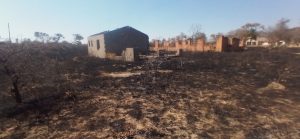
Wildfires under dry conditions have been cited as contributing to the El Nino phenomenon. Credit: Ignatius Banda/IPS
By Ignatius Banda
BULAWAYO, ZIMBABWE, Sep 27 2023 – Zimbabwe is riding a wave of food security assurances after what officials said was last year’s bumper grain harvest, but recent El Niño forecasts could test the country’s agriculture production ambitions.
The devastating phenomenon could further bring the spotlight on Zimbabwe’s disaster preparedness as the country has, over the years, received early warnings of impending climate-induced humanitarian crises but found wanting.
While the landlocked southern African country has invested heavily in farm mechanisation and irrigation, there are concerns that the looming El Niño could test if these interventions will help sustain food production at a time when aid agencies say more people will require assistance into the coming year.
During the 2022/23 season, Zimbabwe recorded its highest grain harvest in years, with the agriculture ministry declaring that the country will not be importing any food in the short term.
However, fresh climate uncertainty concerns have brought back worries about the country’s ability to feed itself, where thousands of smallholder farmers – the primary growers of the staple maize – rely on rain for their agriculture activities.
According to the Food and Agriculture Organisation (FAO), up to 70 percent of Zimbabwe’s population subsists on rainfed agriculture, effectively exposing the vulnerability of food security as El Niño looms.
In a July update, FAO’s Global Information and Early Warning Systems listed Zimbabwe as one of the southern African countries where the UN agency had prepared what it called “anticipatory protocols for drought” ahead of El Niño.
“El Niño is likely to result in a mixed start to the 2023/24 rainy season in Zimbabwe. Precipitation from December to March, during the height of the rainy season, is likely to be below average, negatively impacting the 2023/24 agricultural season,” the Famine Early Warning Systems Network (FEWS-NET) said in a June update.
Climate ministry officials say El Niño has previously affected agricultural production, noting that more remains to be done to counter its devastating effects.
“The combination of drought and water scarcity results in decreased agricultural productivity, leading to reduced food production, and this subsequently impacts food security and increases food prices,” said Washington Zhakata, a director of the Environment Ministry’s Climate Change Management Department.
He noted that the country could still have more to worry about in the aftermath of El Niño.
“El Niño conditions create conducive conditions for the outbreak of crop diseases and pests. When the crops are weakened, they become more susceptible to infestations and diseases, further affecting agricultural yields,” Zhakata told IPS.
While Zimbabwe has committed to building a multi-billion-dollar agriculture sector, climate uncertainty could derail those plans as the country has been slow in setting up infrastructure such as irrigation and new dams.
According to Zhakata, countermeasures such as escalated investment in the sector could cushion the country against future climate shocks.
“Investment in irrigation infrastructure, such as dams, weirs, boreholes and water conveyancing systems to where the water will be required, to provide alternative water sources during drought periods, enhance farmers’ access to irrigation systems, and promote efficient water management practices,” Zhakata said.
This comes as the World Food Programme (WFP) says more people will require food assistance during the traditional lean season early next year, already worsened by El Niño.
“Nutritional vulnerability is highest at the peak of the lean season (January – March) when food stocks from the previous growing season run low and prices in the market increase,” said Mary Gallar, WFP-Zimbabwe spokesperson.
“Recognising the challenges experienced by communities in some poor performing areas, it is expected that a large number of people will rely on food assistance at the beginning of next year,” Gallar said.
According to FAO, El Niño last hit Zimbabwe in 2016 and left 40 million people in southern Africa needing food assistance.
It is yet to be seen what preparations the country’s grain reserves will be enough in the event of another El Niño-induced drought.
According to agencies, the 2016 El Niño “severely reduced seasonal rains and higher-than-normal temperatures linked to El Niño caused an anticipated 12 percent drop in aggregate cereal production.”
Amid such anticipated reduced food production, Zimbabwe’s 2023 bumper grain harvest will provide a litmus test of the country’s grain statistics, which some analysts have questioned.
According to climate ministry officials, Zimbabwe is one of many countries bearing the brunt of climate uncertainty yet to benefit from loss and damage pledges by rich nations, further compounding efforts to address climate-related emergencies adequately.
“The 27th Conference of Parties to the United Nations Framework Convention on Climate Change (COP27) acknowledged that existing funding arrangements fall short of responding to current and future impacts of climate change and are not sufficient to addressing loss and damage associated with the adverse impacts of climate change,” Zhakata said.
“So far, no Parties have benefitted from this facility; it is a prerequisite to have clearly defined operational modalities and initial resources being deposited into the fund before it can be accessed. It is expected that the modalities will be agreed in December to pave the way for the operationalisation of the Fund,” he added.
For now, as potentially devastating El Niño drought approaches, smallholders could find themselves none the wiser as they count their losses in the absence of measures to mitigate the impact of climate change.
IPS UN Bureau Report